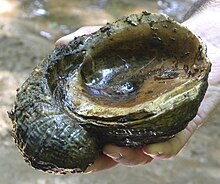Gryphaeidae
| Gryphaeidae Temporal range: [1]
| |
|---|---|

| |
| An intact fossil shell of Exogyra flabellata (Owl Creek Formation, Late Cretaceous, Ripley, Mississippi), held in a human hand | |
| Scientific classification | |
| Kingdom: | Animalia |
| Phylum: | Mollusca |
| Class: | Bivalvia |
| Order: | Ostreida |
| Superfamily: | Ostreoidea |
| Family: | Gryphaeidae Vyalov, 1936 |
| Genera | |
|
See text | |


The Gryphaeidae, common name the foam oysters or honeycomb oysters, are a family of marine bivalve mollusks, and are a kind of true oyster. This family of bivalves is very well represented in the fossil record, however the number of living species is very few.
All species have shells cemented to a substrate. Shells are considered brittle, inequivalve, with the left, lower (cemented) valve convex and the right (upper, non-cemented) valve flat or slightly concave.[2]
Subfamilies[]
Genera and species within this family are divided into three subfamilies, Exogyrinae, Gryphaeinae and Pycnodonteinae. Both Exogyrinae and Gryphaeinae are completely extinct. Only two genera Hyotissa and Neopycnodonte in the subfamily Pycnodonteinae have extant species.[3][4][5]
Genera and species[]
Genera and species within the family Gryphaeidae include: Family Gryphaeidae Vialov, 1936 (some genera also known as Devil's toenails)
- Subfamily †Exogyrinae Vialov, 1936
- Genus †Aetostreon Bayle, 1878
- Genus † Fischer von Waldheim, 1829
- Genus † Vialov, 1936
- Genus †Exogyra Say, 1820
- Genus † Vialov, 1936
- Genus † Conrad, 1865
- Genus † Mirkamalov, 1963
- Genus † Stenzel, 1971
- Genus † Beurlen, 1958
- Genus † Vialov, 1936
- Genus † Lamarck, 1801
- Genus † Vialov, 1936
- Subfamily †Gryphaeinae Vialov, 1936
- Subfamily Pycnodonteinae Stenzel, 1959
- Genus †Gigantostrea (Sacco, 1897)
- Genus Hyotissa Stenzel, 1971
- Genus † Vialov, 1936
- Genus Neopycnodonte Stenzel, 1971
- Genus †Pycnodonte (Fischer von Waldheim, 1835)
- Genus †Texigryphaea Stenzel, 1959
- Subfamily Incertae sedis
- Genus † Bayle, 1878
References[]
- ^ Michael Hautmann; David Ware; Hugo Bucher (2017). "Geologically oldest oysters were epizoans on Early Triassic ammonoids". Journal of Molluscan Studies. 83 (3): 253–260. doi:10.1093/mollus/eyx018.
- ^ Jocelyne Martin; Gérard Paulmier (3 February 2011). Les invertébrés marins du golfe de Gascogne à la Manche orientale. Editions Quae. p. 82. ISBN 978-2-7592-0107-5.
- ^ "Fossilworks: Gryphaeidae". The Paleobiology Database. Retrieved February 6, 2011.
- ^ "Hyotissa Stenzel, 1971". WoRMS - World Register of Marine Species. 2021. Retrieved November 4, 2021.
- ^ Okamura, Kiyoshi; Yamagishi, Yutaka (1992). "Molluscan fauna from the Late Miocene Hatsuse Formation in the Miura Peninsula, Kanagawa Prefecture, Japan" (PDF). Transactions and Proceedings of the Palaeontological Society of Japan (165): 1009–1023. ISSN 0031-0204. Retrieved November 4, 2021.
| Wikispecies has information related to Gryphaeidae. |
- Gryphaeidae
- Extant Early Triassic first appearances
- Bivalve families
- Bivalve stubs